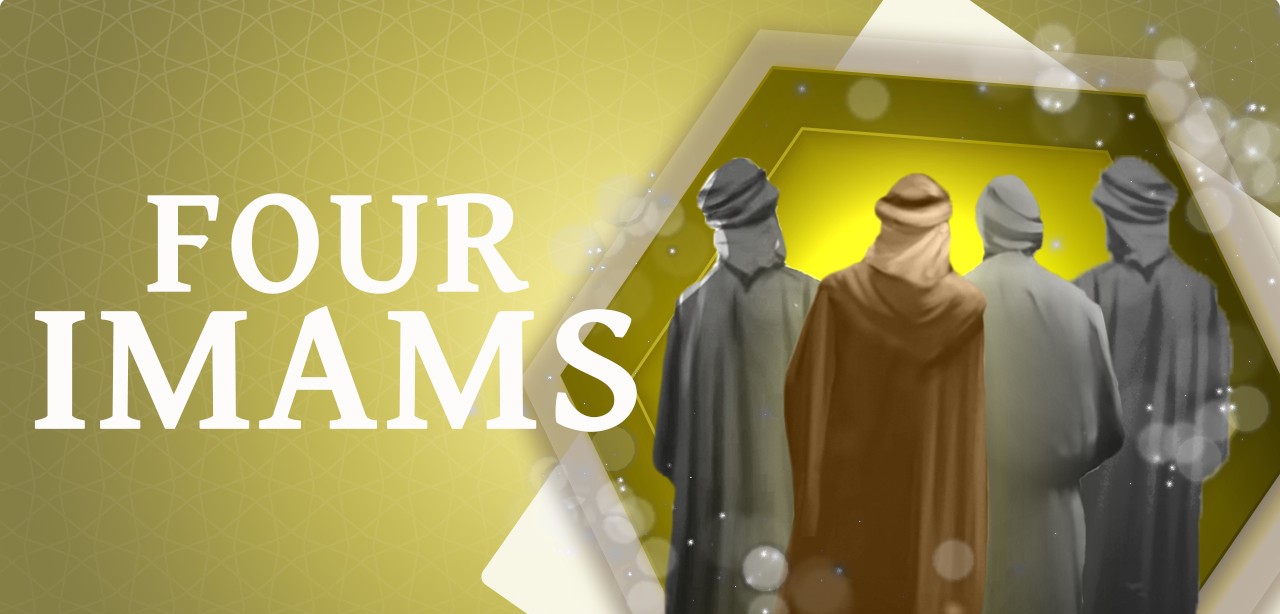The four great Imaams played a major role in the development of Islamic legal theory. They are respectively Imam Abu Hanifa, Imam Malik Bin Anas, Imam Shafi’i and Imam Ahmad Ibn Hanbal. Even though these four blessed souls had different opinions and schools of thought, they had the utmost respect for each other. Let’s consider the contribution of each Imam in Usool-ul Fiqh (The principles of Fiqh).
Imam Abu Hanifa
Nu’man Ibn Thabit, more well known as, Imam Abu Hanifa was born in 80 A.H in Kufa. His school possess the highest number of followers among the four schools. He was known as Imam Al- a’zam. He was the only Tabi’i who had contacts with the companions of Prophet Muhammed ( peace be upon him), among the four great Imaams. He had studied under great scholars like Hammad Basri, Imam Baqir, Imam Ja’fer Sadiq, Abdullah Ibn Umar etc.. And Qadi Abu Yusuf and Imam Muhammed are some of his famous students.
Imam Abu Hanifa was the expert in compilation and classification of Fiqh. He classified Fiqh into functional sub categories, beginning with the purification (Tahara) and later the other Imaams followed his classification. He was well known for his miraculous memory , great taqwa amazing knowledge and skills in Fiqh and Qiyas.
Imam Abu Hanifa viewed Islam as a universal idea and considered Fiqh as a mechanism that would provide a solid foundation to the Islamic nation and would also serve as a frontline in its debate with other nations too. He saw that the Madinite school suffocate to cope with unforeseen Challenges presented by new situations, therefore he expanded the foundation of Jurisprudence. The sources of Fiqh according to him were: the Quran, Sunnah of Prophet Muhammed (peace be upon him), Ijma, Qiyas and Istihsan. Imam Abu Hanifa provided a creative process for the continual evolution of Fiqh. Hanafi School provides the greatest latitude for Ijtihad. Imam Abu Hanifa passed away in 150 A.H , reportedly poisoned by the orders of the Caliph.
Imam Malik Bin Anas
Imam Malik Bin Anas was born in 93 A.H in Madinah. He had a huge respect for his birth place. He studied Fiqh from 95 Shaikhs, some of his teachers were Nafi’ Abuz Zanad, Hisham bin ‘Urwah, Muhammed Bin Muslim bin Shihab Az Zhuhri and other notables. He was greatly attracted towards the study of Islamic law and jurisprudence and dedicated his entire interest to this subject. For his study he sought out more than 300 Tabi’een ( the people who had met the companions of Prophet Muhammed [peace be upon him]) and gained relevant knowledge from them about the Prophet’s Ahadith and Sunnah.
His seminal work, Muwatta (The Approved), written around 150 A.H, contains the most number of Authentic and sound Ahadith. Even Imam Shafi’i considered it to be the most beneficial book after the holy Quran. His book is used in all Islamic institution as a textbook for the final year Ulama graduates. He was also regarded in the highest esteem by the other three of the great Imaams.
Imam Malik’s Madinite School was much more orthodox in its approach to Fiqh. Living in the city of the Prophet and growing up in the light of Islam, most Madinites were attached to the principles of Sunnah of the Prophet (peace be upon him). With the basis of Quran as the primary source, Imam Malik Strengthened the rules of Ijma. The Maliki school spread about Egypt, Libya, Algeria and Morocco through Hajj. It also spread to North Africa, Bedouins of Arabia, Spain and Nigeria. Imam Malik passed away in 179 A.H after an illness and was buried in Jannahtul Baqi.
Imam Shafi’i
Imam Muhammed bin Idris Ash-Shafi’i was born in 150 A.H in Palestine. He was the only one among the four great Imams to share lineage with prophet Muhammed (peace be upon him). He had a miraculous memory and he was able to memorize the Quran by the age of seven and he memorized the Muwatta by the time he turned fifteen.
He went to Makkah when he was 10 and there he began his formal education. He studied Fiqh from famous teachers like Imam Shaybaani, Muslim Bin Khalil al Zanji, Sufyan Bin Uyayna etc.. At the age of 20 he went to Madina and studied under Imam Malik Bin Anas. Imam Malik was greatly impressed with the knowledge of Imam Shafi’i.
Imam Shafi’i is the author of more than 100 books. The most famous works of the Imam include Kitab Al Umm and Kitab Al Hujja which contains the rulings of the Imam on all subjects of Islamic law. Imam Shafi’i was well known for his mastery in Arabic language, knowledge of Hadith, humility and eloquence. He was the first person to establish a formal school of Fiqh. Through his journal named Risalah, he is known to document and examine the basis of Fiqh systematically. His sources of Fiqh were the Quran and the Sunnah. He had issues on certain positions taken by Malik and Hanifa and adopted an independent position on some methodologies. Imam Shafi’i did not accept Istihsan as valid reason. He passed away in 204 A.H.
Imam Ahmad Ibn Hanbal
Imam Ahmad Ibn Hanbal was born in Baghdad in 164 A.H. He is also known as Shaikhul Islam and Imam of Ahl As Sunnah. He was an authority in many disciplines including Fiqh, Hadith, Tafsir, Arabic Language etc..
He has authored a large number of books. He strongly believed in orthodox doctrine of Islam and propagated it. He was a great jurist and his first written manual of Fiqh was named Al Mukhtasar by Al Kiraqi and it is an introductory work on Hanbali Fiqh. He wrote two important books on the orthodox religious doctrine, Kitabus Sunnah and Ar-Rad ‘ala Zanadiqa wal-Jahmiya.
He suffered assault and punishment from Mu’tazzilite ruler of that time under their false ‘Aqeedah of Quran being created by Allah, which would come to mean the Quran to be less perfect. He disagreed with this belief and so he was assaulted.
The Hanbali schools spread in Arabia and Iraq. Hanbali Fiqh is known for its revulsion to any kind of Bid’aa. Imam Ahmad passed away in 241 A.H. His funeral procession was perhaps the largest in the history of Arabia; over one million people attended the funeral.
These four blessed souls, who were also incredible individuals are considered the founding fathers of Fiqh. They played a very vital role in the development of jurisprudence. Their teachings laid the foundation of Fiqh and provided the Muslims with the manual to use to adhere to the laws of Shariah. A study of their lives is a motivation to develop dignity, Sincerity and steadfastness in every soul.
Written by: Zahra Rahman





